Superficial Frostbite
History:
Findings:
There were non-hemorrhagic serous bullae of the dorsal distal digits 2-5 bilaterally extending proximal to the DIP joints with the more ulnar fingers extending to the PIP joints. There was mild erythema extending proximally to the dorsal MCP joints. The pads of the involved fingers appeared swollen and full with erythema of the distal tips that was more prominent on the ulnar fingers. The fingers were warm to the touch with no cyanosis. The right small finger had ruptured bullae with moist underlying dermis with intact, but slightly sluggish, capillary refill and punctate capillary bleeding. It was difficult to appreciate capillary refill in areas of blistering and fullness of the pads. Patient withdrew on examination but unable to differentiate between physical and social discomfort.
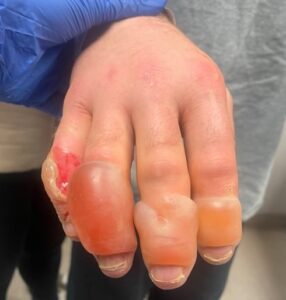
Frostbite to dorsum of right hand 24 hours after injury.
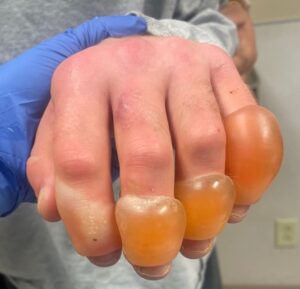
Frostbite to dorsum of left hand 24 hours after injury.
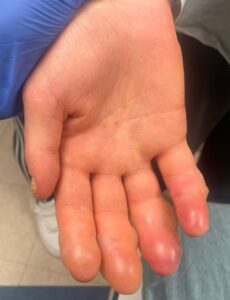
Frostbite to right volar hand 24 hours after injury.
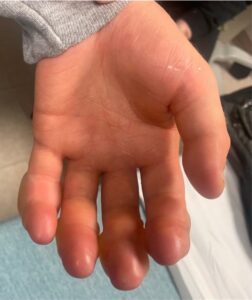
Frostbite to left volar hand 24 hours after injury.
Diagnosis:
Second degree/superficial frostbite of the bilateral fingers 2-5 extending to the DIP radially and PIP joints ulnarly. Frostnip to the dorsal MCP joints digits 2-5
Differential Diagnoses:
- Third degree/deep frostbite injury
- Other thermal injury
- Chemical or topical non-thermal exposure injury
- Systemic desquamating process (such as toxic epidermolysis): inspect the remaining integument system for other areas of epidermolysis
Workup Required:
The areas of frostbite were evaluated for the degree of injury to the soft tissue and stratified based on whether there is reversible tissue ischemia or not. This was dependent on sensation/perfusion following re-warming and amount of time since the injury and re-warming. Sensation to be evaluated following unroofing of the bullae and evaluation of the underlying tissue.
Plan:
Ensure adequate rewarming. Unroof and debride second-degree serous blisters. Evaluate underlying skin for capillary refill, warmth, and distal pulp doppler signal once rewarmed. Perform local wound care and provide adequate pain and anti-inflammatory medications.
Expertise Needed
ED physician, burn specialist and possibly hand surgeon.
Treatment:
The injured tissues were treated in a 40-41 degree water bath for 30 min. The blisters were unroofed using a wet washcloth to mechanically rupture and remove the non-viable skin (Figure 2). Several nail plates were debrided during this process. Once the serous blisters were debrided, the underlying skin had adequate capillary refill and excellent capillary bleeding from the nailbeds, indicating a good prognosis. He was treated initially with daily topical aloe vera gel in loosely fitting medical/food grade gloves. Aloe vera was used for approximately one week for its anti-inflammatory properties. Pain control was provided for the initial debridement and subsequently while wounds are healing. Oral ibuprofen was also administered for its anti-inflammatory properties.
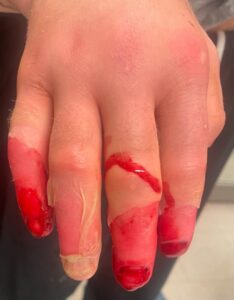
Right hand following debridement of blisters
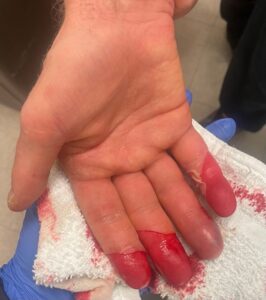
Right hand following debridement of blisters
Follow Up:
At the one-week follow-up appointment, the tips of his fingers continued to appear viable with good capillary refill. He had mild drainage of the fingers, so topical antimicrobial treatment with silver sulfadiazine (SSD) ointment was initiated twice daily.
At his two week follow-up appointment, the skin of the fingers had completely epithelialized (Figure 3). The patient, caretakers, and family were educated that he would likely have lifelong cold sensitivity to these areas and care should be taken to wear appropriate protective clothing when possible. We also discussed that it was suspected that he would have re-growth of his nail plates over the typical 3-6 month time course.

Two-week follow-up appointment with bilateral hands completely epithelialized.

Two-week follow-up appointment with bilateral hands completely epithelialized.

Two-week follow-up appointment with bilateral hands completely epithelialized.
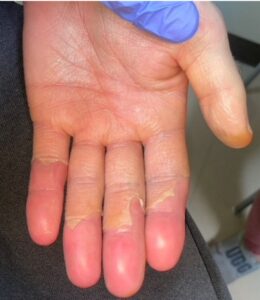
Two-week follow-up appointment with bilateral hands completely epithelialized.

